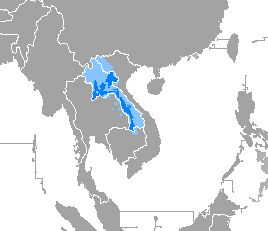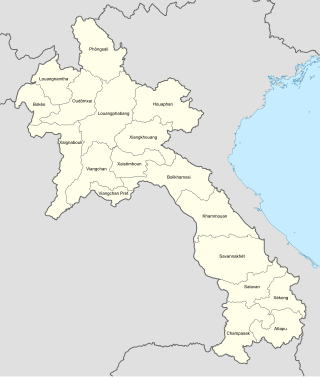
Evidence of modern human presence in the northern and central highlands of Indochina, which constitute the territories of the modern Laotian nation-state, dates back to the Lower Paleolithic. These earliest human migrants are Australo-Melanesians—associated with the Hoabinhian culture—and have populated the highlands and the interior, less accessible regions of Laos and all of Southeast Asia to this day. The subsequent Austroasiatic and Austronesian marine migration waves affected landlocked Laos only marginally, and direct Chinese and Indian cultural contact had a greater impact on the country.

Laos is a country in and the only landlocked nation in mainland Southeast Asia, northeast of Thailand and west of Vietnam. It covers approximately 236,800 square kilometers in the center of the Southeast Asian peninsula and it is surrounded by Myanmar (Burma), Cambodia, the People's Republic of China, Thailand, and Vietnam.

Lao, sometimes referred to as Laotian, is the official language of Laos and a significant language in the Isan region of northeastern Thailand, where it is usually referred to as the Isan language. Spoken by over 3 million people in Laos and 3.7 million in all countries, it serves as a vital link in the cultural and social fabric of these areas. It is written in the Lao script, an abugida that evolved from ancient Tai scripts.

Luang Phabang, or Louangphabang, commonly transliterated into Western languages from the pre-1975 Lao spelling ຫຼວງພຣະບາງ as Luang Prabang, literally meaning "Royal Buddha Image", is a city in north central Laos, consisting of 58 adjacent villages, of which 33 comprise the UNESCO Town of Luang Prabang World Heritage Site. It was listed in 1995 for unique and remarkably well preserved architectural, religious and cultural heritage, a blend of the rural and urban developments over several centuries, including the French colonial influences during the 19th and 20th centuries.

Pakse is the capital and most populous city of the southern Laotian province of Champasak. Located at the confluence of the Xe Don and Mekong Rivers, the district had a population of approximately 77,900 at the 2015 Laotian census. Pakse was the capital of the Kingdom of Champasak until it was unified with the rest of Laos in 1946.

Udon Thani province is one of Thailand's seventy-six provinces (changwat) which lies in upper northeastern Thailand, also called Isan. It is bordered by the provinces of Nong Khai to the north, Sakon Nakhon to the east, Kalasin province to the southeast, Khon Kaen to the south, and Loei and Nong Bua Lamphu to the west. It occupies an area of 11,072 km2 (4,275 sq mi). The total forest area is 1,131 km2 (437 sq mi) or 10.2 percent of provincial area. The provincial capital is Udon Thani, the major city in the province.

Laos, officially the Lao People's Democratic Republic, is divided into 17 provinces and one prefecture, the Vientiane capital city municipality. The special administrative zone, Xaisomboun, created in 1994, was dissolved on 13 January 2006. In 2013, parts of the former special administrative zone was reestablished as Xaisomboun province.

Wattay International Airport is one of the few international airports in Laos and the country's main international gateway, serving the capital Vientiane, located 3 km (1.9 mi) outside of the city centre in Sikhottabong district, Vientiane Prefecture. The airport is operated by the Lao Airport Authority (LAA) and serves as a hub for Lao Skyway, Lao Central Airlines and Lao Airlines. The Lao Air Force also operates an installation at one end of the airport.

The Catholic Church in Laos is part of the worldwide Catholic Church, under the spiritual leadership of the pope in Rome. The Catholic Church is officially recognized by the government.

Christianity is a minority religion in Laos.
The Laotian Chinese are Laotian citizens of Han Chinese ancestry. They constitute one of the many Overseas Chinese residing in Southeast Asia. At present, they constitute an estimated 1 to 2 percent of the Laotian population. The Laotian Chinese community have a disproportionately large presence in the Laotian business sector and dominate the Laotian economy today.

The Apostolic Vicariate of Vientiane is a territorial jurisdiction of the Catholic Church located in northern Laos.

The transport infrastructure of Yunnan is served by numerous transport modes, and forms an integral part of the structure Yunnan Province and the Southwest of China. Yunnan is served by several civilian airports and a major highway and rail network. The province is served by a network of bus routes that radiates from the capital city, Kunming.

Route 13 is the most important highway in Laos. It begins at Boten in northern Laos at the Chinese border. It connects the city of Vientiane to Luang Prabang in the north and roughly follows the line of the Mekong River down to the border with Cambodia. The road then continues at National Highway 7 in Cambodia. Route 13 passes the New Laos National Stadium at Vientiane prefecture and all three international airports in Laos Vientiane Airport, Luang Prabang Airport, and Pakse Airport. Between Boten and Nateuy a 20 km segment of Route 13 is part of the Kunming-Bangkok Expressway,. From Nateuy to Vientiane, Route 13 is part of AH12 and from Vientiane to the border of Cambodia, AH11. It roughly parallels to Vientiane-Boten Expressway.

Laos has 422 km (262 mi) of 1,435 mm standard gauge railways, primarily consisting of the Boten–Vientiane railway, which opened in December 2021. It also has a 12 km (7 mi) metre gauge railway with two stations in Vientiane, Khamsavath and Thanaleng, both of which are connected to Thailand's railway system. There are a total of 22 stations in Laos - 20 on the Boten–Vientiane railway, and 2 linking to the State Railway of Thailand.

Vientiane is the capital and largest city of Laos. Comprising the five urban districts of Vientiane Prefecture, the city is located on the banks of the Mekong, right at the border with Thailand. Vientiane was the administrative capital during French rule and, due to economic growth in recent times, is now the economic center of Laos. The city had a population of 840,000 as of the 2023 Census.

Thanaleng station, also known as Dongphosy station, is a freight railway station in Dongphosy village, Hadxayfong district, Vientiane Prefecture, Laos. It is 20 km (12 mi) east of the Lao capital city of Vientiane and 4 km (2.5 mi) north of the Lao-Thai border on the Mekong River. The station opened for cross-border passenger services from Thailand on 5 March 2009, becoming part of the first international railway link serving Laos.

The Boten–Vientiane railway is the Lao section of the Laos–China Railway (LCR), running between the capital Vientiane and the northern town of Boten on the border with Yunnan, China. The line was officially opened on 3 December 2021.

Vientiane railway station is a railway station in Vientiane, Laos. It is the second station on the Boten–Vientiane railway. The largest and most important station on the line, the station was opened along with the rest of the line on 3 December 2021.

Khamsavath railway station, also known as Vientiane (Khamsavath) railway station and Vientiane-Tai railway station is a railway station located in Nonvai Village, Xaysetha district, Vientiane prefecture, Laos. It is the second railway station serving Vientiane on the State Railway of Thailand's Northeastern Line, located at 7.5 km from the former terminus, Thanaleng station, providing a direct railway connection to Bangkok.


















